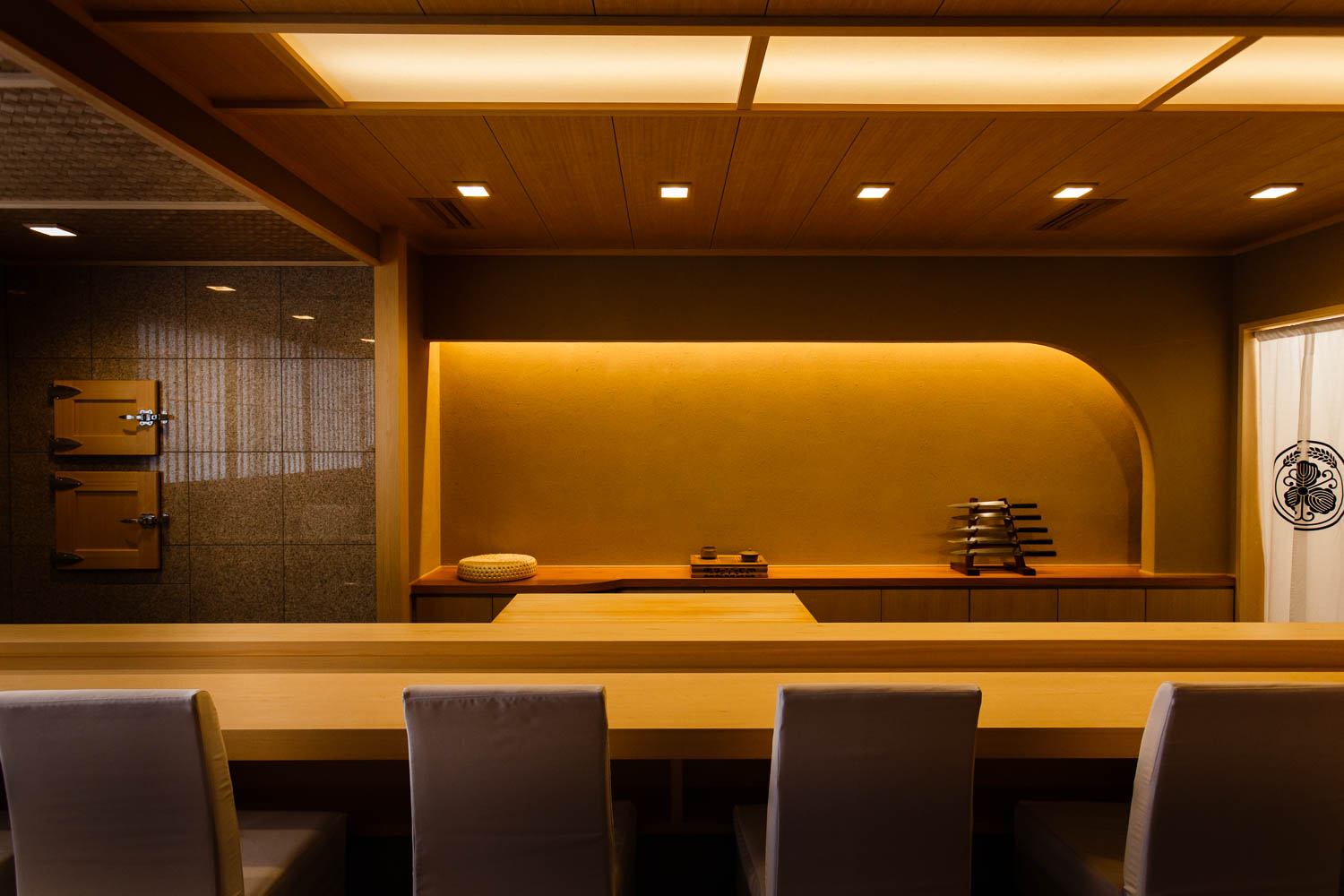
Tokyo
Sushi Ebisu Endo
恵比寿 えんどう
Fueled by great curiosity, Chef Norihito Endo brings the tradition of sushi up to date. A passionate student of Japanese culture, the young owner chef curates a beautiful seasonal menu that is built on tradition but is also evolved with his own unique approach. From its exquisite tea pairing menu to the surprising order of courses, Sushi Endo promises an experience to remember.
Opened in February 2019, the restaurant is found on an uphill road by the railway tracks from Ebisu Station. Located on the fourth floor of a commercial building, Endo chose this particular property because of its spacious interior and large windows that let in plenty of sun into the room.
When you sit down at the counter, the first thing you may notice are two wooden chambers on the wall behind the chef. This is an old-style fridge where the top room is filled with blocks of ice and the lower compartment is where the fish is stored. Compared to electric fridges, the ice chamber helps keep the ideal moisture for the fish to stay fresh, he explains. The smooth counter is made from a plank of hinoki wood that has been matured for over 30 years.
Trained at top-class restaurants like Sushi Mizutani in Ginza and three-star Sushi Saito, Endo’s successful career has earned him an invaluable network of supporters in crafting his own culinary style. Chef Tomoya Kawata of Sazenka helped advise the selection of world teas, while the owner chef of Unagi Hashimoto introduced Endo to their main supplier.
Studious about traditional culture and history, Endo is full of stories about various aspects of his cuisine from ingredients to tableware. He only stocks sake made in breweries he’s personally visited and loves sharing his learnings. “I have a lot to say. Is that ok?” he warns the guests.
Over the years, the chef has accumulated a superb collection of tableware, made up of unique pieces of Bizen ware and kuronuri black lacquerware from Wajima. He often changes the serving trays and bowls to match the beauty of the changing seasons.
CUISINE
Fueled by great curiosity
The omakase meal flows through seasonal flavors. The chef has built his own style where the first course is a bowl of soup, followed by a few small dishes and then a dozen or so nigiris. To people’s surprise, the nigiri courses start with chutoro fatty tuna, followed by gizzard shad, white fish, akami tuna, otoro fatty tuna, squid, shrimp, blackthroat seaperch, sea urchin, salt-water eel, eel and a seasonal roll. The finishing course is a warm soup of shijimi clams.
“French cuisine is like oil painting or an art of addition,” Endo explains. “But Japanese cuisine is like ink-wash painting or an art of subtraction. Sushi, in particular, is like Japanese calligraphy, where the basic shape is fixed but the way you apply the key principles is up to you. The flavor of the expression can vary for every artist.”
From the very start of the meal, Endo surprises his guests with his boldness. Served in a lacquer bowl is a clear ichiban dashi soup with nothing in it. But when you take the first sip, the deep umami seeps through your empty stomach. The broth is made by leaving makombu seaweed in water overnight and flavored with dried bonito flakes precisely at 96 degrees centigrade. The soup is served quite hot at 70-80 degrees.
Before the sushi courses, he serves a number of seasonal appetisers. Suppon turtle, raised in a hot spring in Tohoku area up north, is cooked in a warm broth flavored with soy sauce, mirin and sake. The aromatic sansho peppercorns add a refreshing accent.
The ruby red piece of chutoro fatty tuna drapes beautifully over the shari. Today’s tuna was caught using a fixed net off the shores of Sago on the western coast of Japan.
Eel has become a signature dish of Sushi Endo. At eel restaurants, the fish is typically grilled with sauce and served over a hot bed of rice. Instead, Endo turns it into an elegant piece of sushi by grilling it and just sprinkling some salt. The meat is tender and soft, packed with umami and sweetness.
Aori ika or bigfin reef squid is rested for over three days for its flavor to mature. The spacing between the knife slits is different each time, depending on the condition of the fish. Please enjoy it with just a pinch of salt, he says.
The tea pairing menu offers a selection of six or seven different kinds of tea. Each cup is carefully selected to maximize the flavor of the sushi. White tea from Jun Chiyabari Tea Garden in Nepal complements light-flavored sushi like white fish and beltfish. Gyokuro green tea from Yame in Kyushu Prefecture is paired with squid and shrimp. Leafhopper High Mountain oolong tea goes well with richer flavors like eel and salt-water eel.
INGREDIENTS
Endo carefully selects all the produce that he incorporates into his cuisine. Rice used for the shari is aged koshihikari rice from Ueda in Nagano Prefecture. The grains are large and sweet, while producing a good amount of stickiness. The vinegar is a blend of vintages made by Iio-jozo and Yokoi breweries.
Thanks to an introduction by the owner chef of Unagi Hashimoto, Endo secures his eels from Taisei Yoman in Kagoshima Prefecture. Endo visited the farm with Hashimoto to find which variety of eels was best for sushi. The farm owner recommended a specific type that weighs about 100g and isn’t widely available in the market. The fish is flavorful even served cold.
For the nikiri sauce, he mixes Mitsuru soy sauce from Fukuoka, mirin made by Hakusen Shuzou in Gifu and cooking sake by Matsumoto Sake Brewing. The salt comes from the Goto Islands while the dried bonito flakes are hongarebushi from Makurazaki. For tuna, he likes the soft and aromatic kind, with a slight tint of sourness.
The tea pairing menu is chosen from an extensive collection of 200 to 300 variations. The sake selection, made up of about 10 to 12 vintages, is exclusively from breweries that the chef has visited, allowing him to share his knowledge on each bottle. Reflecting his personal connection with each brewery, he makes sure to include the name of the sake maker in the menu.


CHEF
Norihito Endo
KNIVES
Endo keeps an impressive collection of knives, and also makes sure they are maintained in the best condition. He talks passionately about the art of knife sharpening and how it’s different depending on the material. To make sure it’s done correctly, he hires Masashi Fujiwara, the third generation owner of the Tsukiyama Yoshitaka Cutlery in Mie Prefecture, who comes to the restaurant every two weeks to sharpen the knives. “Even if you have the most impressive knife, if you don’t take care of it, there’s no point in having one.”
Course
- The price includes our booking fee of ¥8,000
- The price includes our booking fee of ¥8,000
- The price includes our booking fee of ¥8,000
- The price includes our booking fee of ¥8,000












